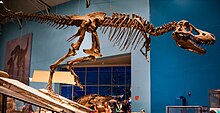
Back Tarbosaurus Afrikaans تربوصور Arabic Tarbosaure Catalan Tarbosaurus CEB Tarbosaurus Czech Tarbosaurus Danish Tarbosaurus German Tarbosaŭro Esperanto Tarbosaurus Basque تاربوسور Persian
| Tarbosaurus Temporal range: Late Cretaceous (Maastrichtian), ~
| |
|---|---|

| |
| Skeleton on exhibit in Maryland Science Center | |
| Scientific classification | |
| Domain: | Eukaryota |
| Kingdom: | Animalia |
| Phylum: | Chordata |
| Clade: | Dinosauria |
| Clade: | Saurischia |
| Clade: | Theropoda |
| Family: | †Tyrannosauridae |
| Subfamily: | †Tyrannosaurinae |
| Clade: | †Tyrannosaurini |
| Genus: | †Tarbosaurus Maleev, 1955b |
| Type species | |
| †Tarbosaurus bataar Maleev, 1955a
| |
| Synonyms | |
|
Species synonymy
| |
Tarbosaurus (/ˌtɑːrbəˈsɔːrəs/ TAR-bə-SOR-əs; meaning "alarming lizard") is a genus of large tyrannosaurid dinosaur that lived in Asia during the Late Cretaceous epoch, about 70 million years ago (Maastrichtian age). It contains the single type species: Tarbosaurus bataar, which is known from the Nemegt Formation of Mongolia, with more fragmentary remains found further afield in the Subashi Formation of China. Tarbosaurus is represented by dozens of fossil specimens, including several complete skulls and skeletons. These remains have allowed studies focusing on its phylogeny, skull mechanics, and brain structure. Further fossil remains have been reported from other geologic formations of Asia, however, these remains are fragmentary and can not be confidentially assigned to Tarbosaurus or the type species.
Like most known tyrannosaurids, Tarbosaurus was a large bipedal predator, with the type specimen measuring approximately 10 metres (33 ft) long, 3 metres (9.8 ft) tall at the hips, and weighing up to 4.5–5 metric tons (5.0–5.5 short tons). It had a unique locking mechanism in its jaw, equipped with about sixty large teeth, and the smallest arms relative to body size of all tyrannosaurids, renowned for their disproportionately tiny, two-fingered hands.
Although many species have been named, modern paleontologists recognize only one species, T. bataar. Some experts see this species as an Asian representative of the North American genus Tyrannosaurus, which would make the genus Tarbosaurus redundant. Tarbosaurus and Tyrannosaurus, if not synonymous, are considered to be very closely related genera. Alioramus, also from Mongolia, has previously been thought by some authorities to be the closest relative of Tarbosaurus, though this has since been disproven with the discovery of Qianzhousaurus and the description of the tyrannosaurine tribe Alioramini.
Tarbosaurus lived in a humid floodplain dominated by deserts, forests and plains, and criss-crossed by river channels. In this environment, it was an apex predator preying on other large dinosaurs, like hadrosaurids, such as Saurolophus and Barsboldia, and sauropods, such as Nemegtosaurus.
© MMXXIII Rich X Search. We shall prevail. All rights reserved. Rich X Search